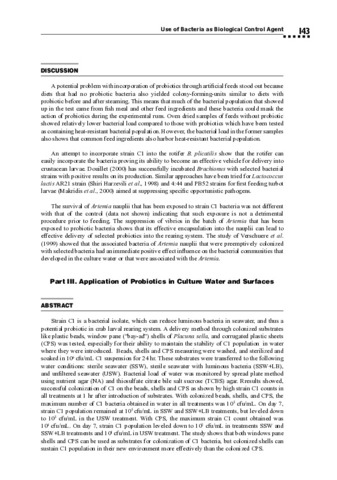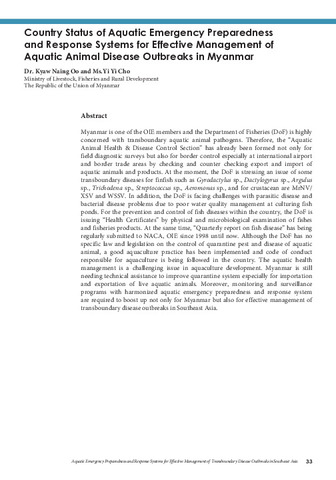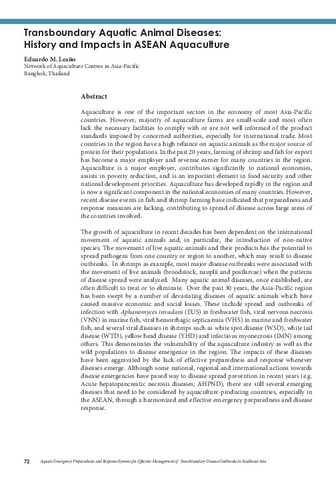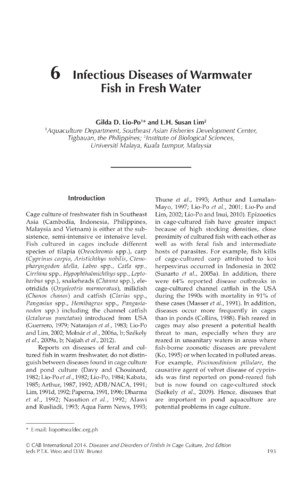Use of bacteria as biological control agent against microbial diseases in shrimp (Penaeus monodon) and crab (Scylla serrata) hatcheries: Part III. Application of probiotics in culture water and surfaces
- Global styles
- MLA
- Vancouver
- Elsevier - Harvard
- APA
- Help

วันที่
2005-03Page views
1,836ASFA keyword
AGROVOC keyword
Taxonomic term
เมตาดาต้า
แสดงระเบียนรายการเต็ม
Share
นามธรรม
Strain C1 is a bacterial isolate, which can reduce luminous bacteria in seawater, and thus a potential probiotic in crab larval rearing system. A delivery method through colonized substrates like plastic beads, window pane (“bay-ad”) shells of Placuna sella, and corrugated plastic sheets (CPS) was tested, especially for their ability to maintain the stability of C1 population in water where they were introduced. Beads, shells and CPS measuring were washed, and sterilized and soaked in 106 cfu/mL C1 suspension for 24 hr. These substrates were transferred to the following water conditions: sterile seawater (SSW), sterile seawater with luminous bacteria (SSW+LB), and unfiltered seawater (USW). Bacterial load of water was monitored by spread plate method using nutrient agar (NA) and thiosulfate citrate bile salt sucrose (TCBS) agar. Results showed, successful colonization of C1 on the beads, shells and CPS as shown by high strain C1 counts in all treatments at 1 hr after introduction of substrates. With colonized beads, shells, and CPS, the maximum number of C1 bacteria obtained in water in all treatments was 105 cfu/mL. On day 7, strain C1 population remained at 105 cfu/mL in SSW and SSW+LB treatments, but leveled down to 103 cfu/mL in the USW treatment. With CPS, the maximum strain C1 count obtained was 104 cfu/mL. On day 7, strain C1 population leveled down to 102 cfu/mL in treatments SSW and SSW+LB treatments and 101 cfu/mL in USW treatment. The study shows that both windows pane shells and CPS can be used as substrates for colonization of C1 bacteria, but colonized shells can sustain C1 population in their new environment more effectively than the colonized CPS.
การอ้างอิง
Lavilla-Pitogo, C. R., de la Peña, L. D., & Catedral, D. D. (2005). Use of bacteria as biological control agent against microbial diseases in shrimp (Penaeus monodon) and crab (Scylla serrata) hatcheries: Part III. Application of probiotics in culture water and surfaces. In K. Nagasawa (Ed.), Recent Advances in Diagnosis and Prevention of Fish and Shrimp Diseases in Southeast Asia (pp. 143–152). Tigbauan, Iloilo, Philippines: Aquaculture Department, Southeast Asian Fisheries Development Center.
Type
Book chapterISBN
9718511732
Related items
Showing items related by title, author, creator and subject.
-
Country status of aquatic emergency preparedness and response systems for effective management of aquatic animal disease outbreaks in Myanmar
Oo, Kyaw Naing; Cho, Yi Yi (Aquaculture Department, Southeast Asian Fisheries Development Center, 2019)Myanmar is one of the OIE members and the Department of Fisheries (DoF) is highly concerned with transboundary aquatic animal pathogens. Therefore, the Aquatic Animal Health & Disease Control Section has already been ... -
Transboundary aquatic animal diseases: History and impacts in ASEAN aquaculture
Leaño, Eduardo M. (Aquaculture Department, Southeast Asian Fisheries Development Center, 2019)Aquaculture is one of the important sectors in the economy of most Asia-Pacific countries. However, majority of aquaculture farms are small-scale and most often lack the necessary facilities to comply with or are not well ... -
Infectious diseases of warmwater fish in fresh water
Lio-Po, Gilda D.; Lim, L. H. Susan (CABI Publishing, 2014)This chapter presents the viral, bacterial, pseudofungal and parasitic diseases in cultured warm freshwater fish. Focus is given on the distribution, causative agent, pathology, diagnosis, prevention and control of these diseases.

 AQD Access
AQD Access




